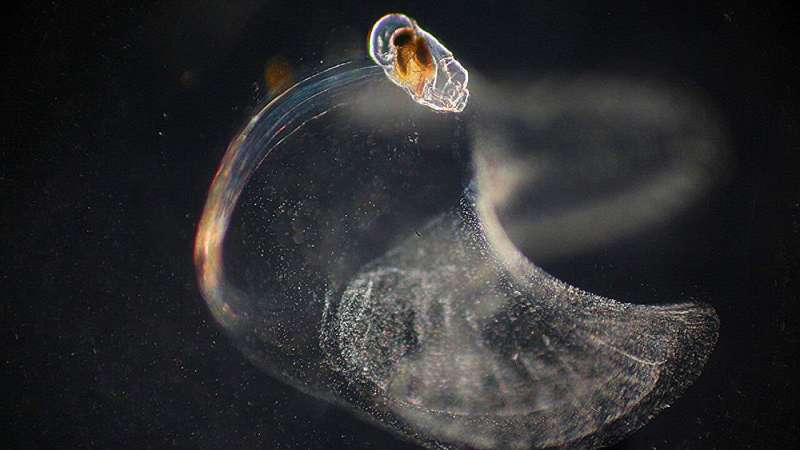This article has been reviewed according to Science X's editorial process and policies. Editors have highlighted the following attributes while ensuring the content's credibility:
fact-checked
peer-reviewed publication
trusted source
proofread
How a sea animal with a 'snot palace' could inspire better pumps

To build more efficient pumping systems, engineers might take inspiration from a tiny filter-feeding sea creature encased in a gelatinous structure known as a "mucus house" or "snot palace."
New University of Oregon research shows that the wavelike movement of the animal's tail inside the snug chamber propels fluid and food particles consistently forward, closer to the mouth. The unique design of that biological pump could provide inspiration for new kinds of human-made pumps for applications like wastewater treatment.
The research is described in a paper published on Nov. 15 in the Journal of the Royal Society Interface.
"Pumps are everywhere in nature, but this pump is unique in driving fluid through a filter by beating a tail inside a sealed chamber," said Kelly Sutherland, a biologist at the UO's Oregon Institute of Marine Biology. "Plus, the animals are so mesmerizing to observe."
The study looked at a species called Oikopleura dioica, which belongs to a group of small filter-feeding animals called larvaceans. Those critters, about a millimeter long, look like miniature tadpoles even as adults. Their wriggly tails propel them through the ocean and also help them to filter feed, collecting small food particles on mucus mesh filters.
Collectively, they have an outsized impact on ocean ecosystems; their powerful pumping mechanism removes particles at enormous rates and even pulls microplastics from the water.
When it's time to eat, larvaceans secrete a casing that surrounds their body, using their tails to inflate it like pumping up a pool toy. This mucus house has filters that trap food particles and direct them towards the mouth.
Then, when finished, the animal abandons the mucus house, sliding out via an escape hatch and letting the mucus remnants slowly sink down. A larvacean will make and shed a mucus house many times a day.
"It's so cool. It's a pretty complex structure," said Terra Hiebert, a research associate in Sutherland's lab who led the analysis.
To understand more about how this particular larvacean feeds, Sutherland and her colleagues traveled to a specialized research facility in Bergen, Norway, that breeds the critters. They used a microscope and a high-speed video camera to trace the flow of fluid and small particles around the larvaceans under different conditions.
The addition of the mucus house around the tail changed the way water and particles flow, creating a unique pumping system, the videos revealed.
In its free-swimming state, wiggling the tail and bending the body side-to-side propels the animal forward in the water. But when the mucus house encases the tail, the dynamics change. The animal remains relatively stationary in the ocean, while water and particles move parallel to the tail, propelled across the mucus mesh filters and guided into the animal's mouth.
The difference is driven by the way the tail fits snugly inside the mucus house, touching the sides in several places, the researchers found. As the tail wiggles back and forth, it seals and unseals from the mucus case at specific attachment points, like Velcro.
The seal builds pressure that pushes the fluid continuously forward and prevents backward flow. As particles collect on the filters, the next wave of fluid pushes them forward and funnels them into the animal's mouth.
"They use this relatively unique pumping strategy, with a sinusoidal tail and a snug fit within chamber," Hiebert said, using a term for a wavelike tail. "Because of the snug fit, there's very little backward displacement of water."
The larvacean's filtration system is an example of a peristaltic pump, a kind of system that's often used in water treatment plants and other industrial settings. In most peristaltic pumps, the forward movement of fluid comes from external squeezing, as in the colon, where rhythmic contractions in the intestines push waste through the system. But in these tiny filter feeders, the propulsion comes instead from the movement of something inside the pump, in this case, the tail.
That could be a more efficient design that protects the moving parts of a pump, lowering their risk of wearing out, the researchers suggest.
"This new understanding of larvacean pumps helps us understand the ecological success of a widespread organism and may even inspire the next generation of water or air filters in the built environment," Sutherland said.
More information: Terra C. Hiebert et al, The hydrodynamics and kinematics of the appendicularian tail underpin peristaltic pumping, Journal of the Royal Society Interface (2023). DOI: 10.1098/rsif.2023.0404
Journal information: Journal of the Royal Society Interface
Provided by University of Oregon



















